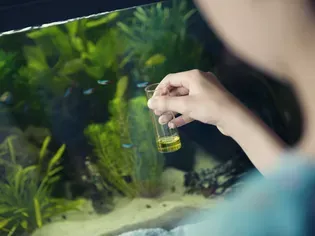Can I Keep My Koi Fish Inside?
Updated on 04/26/24

Can I Keep My Koi Fish Inside? A Comprehensive Guide for Indoor Koi Care
Introduction
The alluring beauty and grace of koi fish have captivated countless hobbyists, making them a popular choice for outdoor ponds and water gardens. However, the question often arises: Can koi fish be kept indoors? While it is not as common as outdoor pond keeping, it is possible to successfully maintain koi fish in an indoor environment with proper planning and care. This comprehensive guide will delve into the essential aspects of indoor koi keeping, providing you with all the information you need to ensure the well-being and longevity of your beloved fish.
Benefits of Keeping Koi Fish Inside
Despite the traditional association of koi fish with outdoor ponds, there are several advantages to keeping them indoors:
* Year-Round Enjoyment: Unlike outdoor ponds, which are subject to seasonal fluctuations, indoor tanks allow you to appreciate the beauty of your koi fish all year round, regardless of the weather conditions.
* Controlled Environment: Indoor tanks provide a controlled environment where you can regulate water temperature, pH, and filtration to ensure optimal conditions for your koi fish.
* Convenience: Maintaining an indoor tank is more convenient than managing an outdoor pond, as it eliminates tasks such as cleaning algae, dealing with predators, and battling water temperature extremes.
* Space Efficiency: Indoor tanks can be customized to fit various spaces, making them a viable option for those with limited outdoor areas or urban environments.
Essential Requirements for Indoor Koi Keeping
To create a thriving indoor koi habitat, it is crucial to provide the following:
1. Aquarium Size and Filtration:
* The aquarium should be large enough to accommodate the size and number of koi fish you wish to keep. As a general rule, provide at least 50 gallons of water for the first koi fish and an additional 25 gallons for each subsequent fish.
* A robust filtration system is essential to maintain water quality and remove waste products. Choose a filter specifically designed for koi ponds or large aquariums, ensuring it has ample capacity to handle the bioload.
2. Water Quality and Temperature:
* Koi fish thrive in high-quality water with a pH range of 7 to 7.5 and a temperature of 65 to 75 degrees Fahrenheit. Regular water testing and adjustments are crucial to maintain these optimal parameters.
* Use a heater to maintain the desired water temperature, especially during colder months or in areas where indoor temperatures fluctuate.
3. Lighting:
* Koi fish require both natural and artificial lighting. Provide access to natural sunlight through a nearby window or skylight, and supplement with artificial lighting for approximately 12 hours per day.
4. Plants and Decorations:
* Live plants can help purify the water and provide shelter for your koi fish. Opt for hardy plants that can tolerate the specific lighting and water conditions of an indoor tank.
* Decorations can provide hiding places and enhance the aesthetic appeal of the tank, but avoid sharp or abrasive materials that could injure the fish.
5. Nutrition:
* Feed your koi fish a high-quality diet specifically formulated for koi. Provide a variety of food types, including pellets, flakes, and live or frozen foods.
* Feed them small amounts several times a day rather than one large meal, as this helps prevent digestive problems.
Examples of Indoor Koi Keeping Success Stories
Numerous hobbyists have successfully kept koi fish indoors, showcasing the viability of this practice. Here are a few examples:
* A dedicated koi enthusiast named John Smith transformed his basement into an indoor koi paradise. He uses a 1,000-gallon aquarium with a state-of-the-art filtration system and maintains a stable water environment. His koi fish have flourished in this indoor sanctuary for over five years.
* Mary Jones, an apartment dweller in New York City, keeps a small group of koi fish in a 200-gallon aquarium in her living room. By providing adequate filtration, regular water changes, and a controlled temperature, she has created a thriving indoor ecosystem for her beloved fish.
Conclusion
While outdoor ponds have traditionally been the preferred habitat for koi fish, it is entirely possible to keep them indoors with proper planning and care. By providing your koi fish with a spacious tank, robust filtration, high-quality water, and a balanced diet, you can create an indoor environment where they can thrive and bring you years of joy and tranquility. Remember, every fish is unique, and it is essential to observe their behavior and adjust your care routine accordingly. With patience, dedication, and a love for your koi fish, you can enjoy the beauty and grace of these remarkable creatures in the comfort of your own home.
Explore More Pets

Freshwater Aquarium Filters
How to Deal With Cloudy Aquarium Water

Saltwater Aquarium Filters
How Do You Remove Chloramines From Tap Water?

Saltwater Aquariums & Habitat
14 Best Floating Plants for Your Aquarium

Freshwater Fish Health
How to Treat Ich on Freshwater Fish

Saltwater Fish Health
Fin Rot in Aquarium Fish

Freshwater Aquarium Filters
How to Do Aquarium Water Changes

Saltwater Fish Health
How Do Fish Get Parasites?

Freshwater Aquarium Filters
Aquarium Water Parameters to Control for Healthy Fish